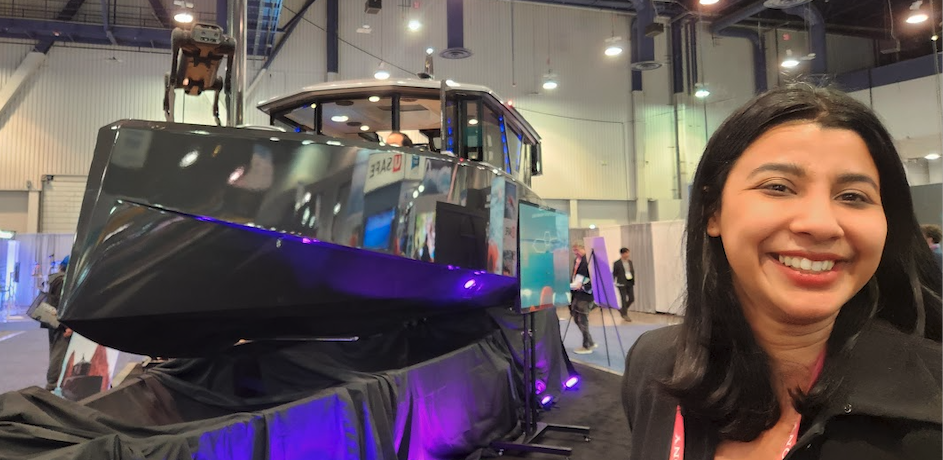A framework that allows four-legged robots to follow a leader in both daytime and nighttime conditions
FORVIA
The robots of CES 2023

Robots were on the main expo floor at CES this year, and these weren’t just cool robots for marketing purposes. I’ve been tracking robots at CES for more than 10 years, watching the transition from robot toys to real robots. Increasing prominence has been given to self-driving cars, LiDARs and eVTOL drones, but, in my mind it was really the inclusion of John Deere and agricultural robots last year that confirmed that CES was incorporating more industry, more real machines, not just gadgets.
In fact, according to the organizing association CTA or the Consumer Technology Association, these days CES no longer stands for the Consumer Electronics Show. CES now just stands for CES, one of the world’s largest technology expos.

Eve from Halodi Robotics shakes hands at CES 2023 with Karinne Ramirez-Amaro, associate professor at Chalmers University of Technology and head of IEEE Robotics and Automation Society’s Women in Engineering chapter. (Image source: Andra Keay)
The very first robot I saw was Eve from Halodi Robotics, exhibiting in the ADT Commercial booth. I am a big fan of this company. Not only do they have great robotics technology, which is very safe and collaborative, but I’ve watched them go from an angel funded startup to their first commercial deployments, providing 140 robots to ADT. One of their secrets has been spending the last year working closely with ADT to finetune the first production features of Eve, focusing on indoor security and working alongside people. In the future, Halodi has potential for many other applications including eldercare.
Another robot company (and robot) that I’m a big fan of is Labrador Robotics, and their mobile tray fetching robot for eldercare. Labrador exhibited their mobile robot in the AARP Innovation Lab pavilion, and are rolling out robots both in houses and in aged care facilities. There are two units pictured and the height of the platform can raise or lower depending on whether it needs to reach a countertop or fridge unit to retrieve items, like drinks and medications, or whether it needs to lower to become a bed or chair side table. These units can be commanded by voice, or tablet, or scheduled to travel around designated ‘bus stops’, using advanced localization and mapping. The team at Labrador have a wealth of experience at other consumer robotics companies.

Two Retrievers from Labrador Robotics in the AARP Innovation Lab Pavilion at CES 2023. (Image source: Andra Keay)
I first met Sampriti Battacharya, pictured below with her autonomous electric boat, when she was still doing her robotics PhD at MIT, dreaming about starting her own company. Five short years later, she’s now the proud founder of Navier with not one but two working prototypes of the ‘boat of the future’. The Navier 30 is a 30’ long electric intelligent hydrofoil with a range of 75 nautical miles and a top speed of 35 knots. Not only is the electric hydrofoil 90% more energy efficient than traditional boats but it eliminates sea sickness with a super smooth ride. Sampriti’s planning to revolutionize public transport for cities that span waterways, like San Francisco or Boston or New York.

Navier’s ‘boat of the future’ with founder Sampriti Battacharya, plus an extra stowaway quadruped robot from Unitree. Image source: Andra Keay
Another rapidly evolving robotics company is Yarbo. Starting out as a prototype snow blowing robot, after five years of solid R&D, Snowbot has evolved into the Yarbo modular family of smart yard tools. Imagine a smart docking mobile base which can be turned from a lawn mower to a snow blower or a leaf blower. It can navigate autonomously, and it’s electric of course.
And these robotics companies are making waves at CES. I met French startup Acwa Robotics earlier in 2022 and was so impressed that I nominated them as an IEEE Entrepreneurship Star. Water utilities around the world are faced with aging and damaged infrastructure, inaccessible underground pipes, responsible for huge amounts of water loss, road and building damage. Acwa’s intelligent robot travels inside the pipes without stopping water flow and provides rapid precisely localized inspection data that can pinpoint leaks, cracks and deterioration. Acwa was nominated for honors in the Smart Cities category and also won CES Best of Innovation Award.

Acwa Robotics and CES 2023 Best of Innovation Awards (Image Source: Acwa Robotics)
Some other robotics companies and startups worth looking at were Apex.ai, Caterpillar, Unitree, Bosch Rexroth, Waymo, Zoox, Whill, Meropy, Artemis Robotics, Fluent Pet and Orangewood. Let me know who I missed! According to the app, 278 companies tagged themselves as Robotics, 73 as Drones, 514 as Vehicle Tech, and 722 as Startups, although I’d say the overall number of exhibitors and attendees was down on previous years although there were definitely more robots.
Click beetle-inspired robots jump using elastic energy
Soft robots harness viscous fluids for complex motions
A method to enable robotic paper folding based on deep learning and physics simulations
Rotational multimaterial printing of helical filaments for soft robotics and structural composites
Warehouse Robots and Why Flooring is Important
Robotics research: How Asia, Europe and America invest – Global Report 2023
Countries around the world invest in robotics to support developments in industry and society. What are the exact targets of robotics research funding programs (R&D) officially driven by governments in Asia, Europe and America today? This has been researched by the International Federation of Robotics and published in the 2023 update paper of “World Robotics R&D Programs”.

© Pixabay
“The 3rd version of World Robotics R&D Programs covers the latest funding developments including updates in 2022,” says Prof. Dr. Jong-Oh Park, Vice-Chairman IFR Research Committee and member of the Executive Board.
The overview shows that the most advanced robotics countries in terms of annual installations of industrial robots – China, Japan, USA, South Korea, Germany – and the EU drive very different R&D strategies:
Robotics R&D programs – officially driven by governments
In China, the “14th Five-Year Plan” for Robot Industry Development, released by the Ministry of Industry and Information Technology (MIIT) in Beijing on 21st December 2021, focuses on promoting innovation. The goal is to make China a global leader for robot technology and industrial advancement. Robotics is included in 8 key industries for the next 5 years. In order to implement national science and technology innovation arrangements, the key special program “Intelligent Robots” was launched under the National Key R&D Plan on 23rd April 2022 with a funding of 43.5 million USD. The recent statistical yearbook “World Robotics” by IFR shows that China reached a robot density of 322 units per 10,000 workers in the manufacturing industry: The country ranks 5th worldwide in 2021 compared to 20th (140 units) in 2018.
In Japan, the “New Robot Strategy” aims to make the country the world´s number one robot innovation hub. More than 930.5 million USD in support has been provided by the Japanese government in 2022. Key sectors are manufacturing (77.8 million USD), nursing and medical (55 million USD), infrastructure (643.2 million USD) and agriculture (66.2 million USD). The action plan for manufacturing and service includes projects such as autonomous driving, advanced air mobility or the development of integrated technologies that will be the core of next-generation artificial intelligence and robots. A budget of 440 million USD was allocated to robotics-related projects in the “Moonshot Research and Development Program” over a period of 5 years from 2020 to 2025. According to the statistical yearbook “World Robotics” by IFR, Japan is the world´s number one industrial robot manufacturer and delivered 45% of the global supply in 2021.
The 3rd Basic Plan on Intelligent Robots of South Korea is pushing to develop robotics as a core industry in the fourth industrial revolution. The Korean government allocated 172.2 million USD in funding for the “2022 Implementation Plan for the Intelligent Robot”. From 2022 to 2024 a total of 7.41 million USD is planned in funding for the “Full-Scale Test Platform Project for Special-Purpose Manned or Unmanned Aerial Vehicles”. The statistical yearbook “World Robotics” showed an all-time high of 1,000 industrial robots per 10,000 employees in 2021. This makes Korea the country with the highest robot density worldwide.
Horizon Europe is the European Union’s key research and innovation framework program with a budget of 94.30 billion USD for seven years (2021-2027). Top targets are: strengthening the EU’s scientific and technological bases, boosting Europe’s innovation capacity, competitiveness and jobs as well as delivering on citizens’ priorities and sustaining socio-economic models and values. The European Commission provides total funding of 198.5 million USD for the robotics-related work program 2021-2022.
Germany´s High-Tech Strategy 2025 (HTS) is the fourth edition of the German R&D and innovation program. The German government will provide around 69 million USD annually until 2026 – a total budget of 345 million USD for five years. As part of the HTS 2025 mission, the program “Shaping technology for the people” was launched. This program aims to use technological change in society as a whole and in the world of work for the benefit of people. Research topics are: digital assistance systems such as data glasses, human-robot-collaboration, exoskeletons to support employees in their physical work, but also solutions for the more flexible organization of work processes or the support of mobile work. According to the report “World Robotics” by IFR, Germany is the largest robot market in Europe – the robot density ranks in 4th place worldwide with 397 units per 10,000 employees.
The National Robotics Initiative (NRI) in the USA was launched for fundamental robotics R&D supported by the US government. The NRI-3.0 program, announced in February 2021, seeks research on integrated robot systems and builds upon the previous NRI programs. The US government supported the NRI-3.0 fund to the sum of 14 million USD in 2021. Collaboration among academics, industry, government, non-profit, and other organizations is encouraged. The “Moon to Mars” project by NASA for example highlights objectives to establish a long-term presence in the vicinity of and on the moon. The projects target research and technology development that will significantly increase the performance of robots to collaboratively support deep space human exploration and science missions. For the Artemis lunar program, the US government is planning to allocate a budget of 35 billion USD from 2020 to 2024. The statistical yearbook “World Robotics” by IFR shows that robot density in the United States rose from 255 units in 2020 to 274 units in 2021. The country ranks 9th in the world. Regarding annual installations of industrial robots, the USA takes 3rd position.
Boston Dynamics Atlas Gets a Grip
Boston Dynamics Atlas Gets a Grip
Robot Talk Episode 33 – Interview with Dan Stoyanov

Claire chatted to Professor Dan Stoyanov from University College London all about robotic vision, surgical robotics, and artificial intelligence.
Dan Stoyanov, FREng, FIET, is a Professor at UCL Computer Science holding a Royal Academy of Engineering Chair in Emerging Technologies. He is Director of the Wellcome/EPSRC Centre for Interventional and Surgical Sciences (WEISS), a large research centre combining engineering and clinical expertise. His research interests are focused on surgical robotics, surgical data science and the development of surgical AI systems for clinical use. He is Chief Scientist at Digital Surgery, and he co-founded Odin Vision Ltd as a UCL spin-out focused on AI in gastroenterology.